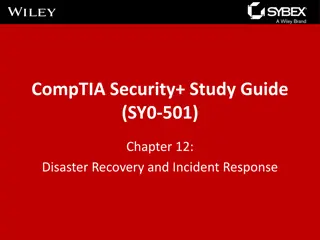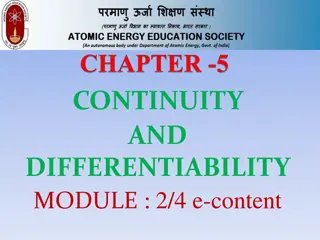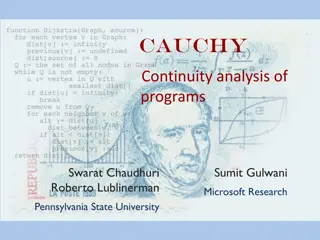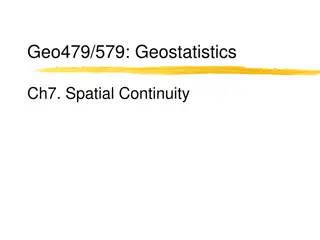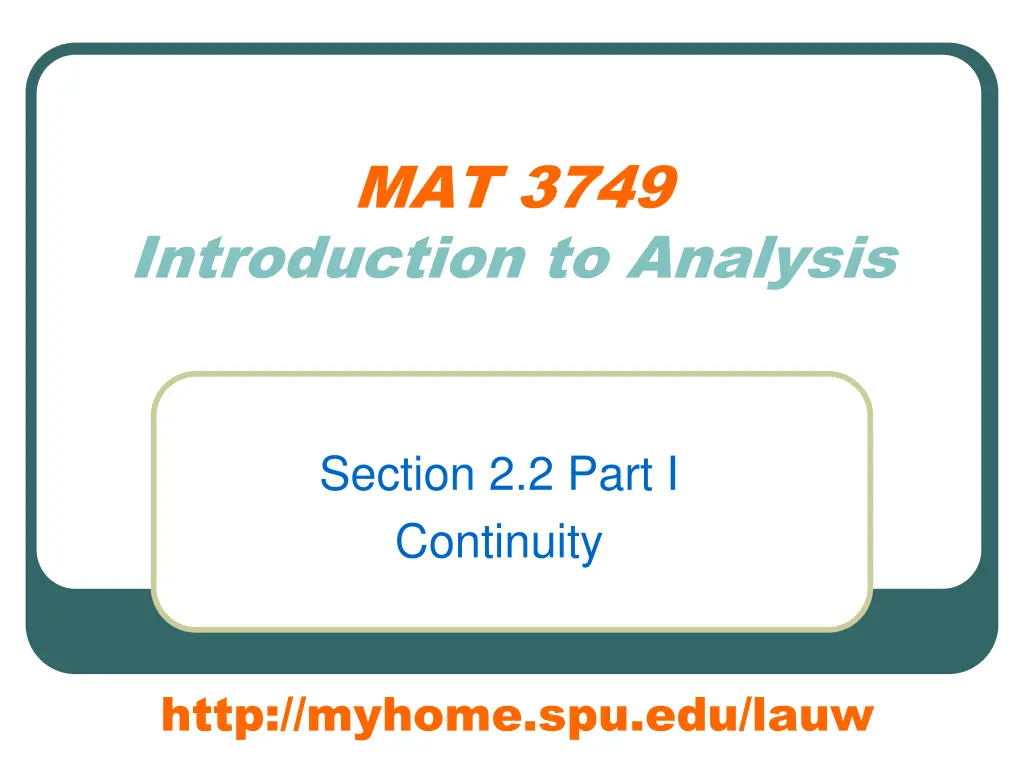
Understanding Continuity of Functions: Definitions and Examples
Explore the concept of continuity in functions, including the e-d definition, Intermediate Value Theorem, arranged marriage analogy, and continuous functions on open intervals. Learn how to prove continuity at specific points and intervals using the e-d definition and modified definitions for non-open intervals.
Uploaded on | 1 Views
Download Presentation

Please find below an Image/Link to download the presentation.
The content on the website is provided AS IS for your information and personal use only. It may not be sold, licensed, or shared on other websites without obtaining consent from the author. If you encounter any issues during the download, it is possible that the publisher has removed the file from their server.
You are allowed to download the files provided on this website for personal or commercial use, subject to the condition that they are used lawfully. All files are the property of their respective owners.
The content on the website is provided AS IS for your information and personal use only. It may not be sold, licensed, or shared on other websites without obtaining consent from the author.
E N D
Presentation Transcript
MAT 3749 Introduction to Analysis Section 2.2 Part I Continuity http://myhome.spu.edu/lauw
Preview The (e-d) definition for continuity of functions at a point Continuous from the left/right. Intermediate Value Theorem.
References Section 2.2
Arranged Marriage and Continuity
Example 1 ( ) f x = 2 x Use the e-d definition to prove that is continuous at 2.
Analysis ( ) f x = 2 x Use the e-d definition to prove that is continuous at 2.
Continuous on an Open Interval A function ? is continuous on an open interval if it is continuous at every number of the interval.
Example 2 1 x ( ) f x = Use the e-d definition to prove that is continuous on . ( ) 0,
Analysis 1 x ( ) f x = Use the e-d definition to prove that is continuous on . ( ) 0,
What if If the interval is not open, the definition above breaks down at the end points. A different (modified) definition is required.
Continuous on an Interval Continuous on an Interval A function is continuous on an interval if it is continuous at every number of the interval. (We understand continuous at the end points to mean continuous from the left/right.)
Common Continuous Functions Polynomials Power functions Rational Functions Root Functions Tri. Functions Continuous at every no. in their domains
Combinations of Continuous Functions If ? and ? is continuous at ?, then ? + ?, ? ?, ??, ?/?*, ?? are also continuous at ?. = + ( ) f x ( ) g x y = ( ) g x y = ( ) f x y ( ?(?) 0)
Combinations of Continuous Functions If ? is continuous at ?, and ? is continuous at ? = ?(?), then the composite function f g is also continuous at ?.
Analysis If ? is continuous at ?, and ? is continuous at ? = ?(?), then the composite function f g is also continuous at ?.
Intermediate Value Theorem Suppose ? is continuous on [?,?] with ?(?) ?(?) and ? is between ?(?) and ?(?) Then there is a no. ? in (?,?) such that ?(?) = ?
Intermediate Value Theorem Suppose ? is continuous on [?,?] with ?(?) ?(?) and ? is between ?(?) and ?(?)
Intermediate Value Theorem There are usually two type of proofs. Use sequences Use contradictions to argue that and We will come back to the proofs in next class ( ) f c ( ) f c N N
Applications Use to prove other theorems Use to estimate the roots of equations Find ? such that ?(?) = 0
Applications Suppose ? is continuous on [?,?] and that ?(?), ?(?) are with different signs Then there is a no. ? in (?,?) such that ?(?) = 0 ( ) f x ( ) f b a x c 0 b ( ) f a
Analysis/Proof Suppose ? is continuous on [?,?] and that ?(?), ?(?) are with different signs Then there is a no. ? in (?,?) such that ?(?) = 0 ( ) f x ( ) f b a x c 0 b ( ) f a
Note We are going to call both of these results as IVT. In fact, we can prove one result as the consequence of the other result (HW)
Example 3 Show that there is a root of the equation 4 6 x + = 3 2 3 2 0 x x between 1 and 2.
Analysis Show that there is a root of the equation 4 6 x + = 3 2 3 2 0 x x between 1 and 2.
Solution Show that there is a root of the equation 4 6 x + = 3 2 3 2 0 x x between 1 and 2.










